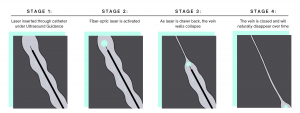Not liking the look of bulging and discoloured veins can often be a sufficient reason to get them treated. If not, there are also some important health risks to consider if you choose to ignore varicose veins. We discuss the dangers of not treating varicose veins.
What are Varicose Veins:
Varicose veins are commonly known by their bulging, worm-like appearance on the legs. But what’s going on below the skin? Well, every vein has valves that help to prevent the backflow of blood. When these valves become damaged, pools of blood can form in the region, causing the vein to become enlarged. These veins often appear at the skin’s surface swollen and twisted or they are sometimes hidden within the fat and only seen through ultrasound. Usually, less than 5% of blood flow is carried through these damaged veins.
Dangers of not treating Varicose Veins:
If symptomatic varicose veins are left untreated, it can result in further problems throughout the body.
Below are some common complications of varicose veins:
Swelling –
Untreated venous disease manifested as varicose veins often cause generalised swelling of the limb affected. This can create heaviness in the leg, poor skin quality, uneven limb size, increased blood pressure, pain and significant discomfort. Many symptoms will manifest towards the end of the day when pooling and gravity has made it difficult for the body to manage the swelling.
Dangers to the Skin if Varicose Veins are left untreated:
Overall skin quality –
Prolonged swelling can, over time, cause significant changes to the skin. The swollen tissue, that is caused by varicose veins, can restrict the flow of oxygen and nutrients that help the normal healing process. This causes surrounding skin to become less likely to heal from minor injuries in the area.
Hyperpigmentation –
Untreated varicose veins can often result in an excess of blood leaking into the surrounding tissue. This can cause parts of the skin to become dark and discoloured. This is often seen around the ankle.
Skin Ulcers –
The persistent swelling of varicose veins, and deterioration of skin quality in the area can also create non-healing ulcers. This means that wounds that would usually heal through blood flow, such as small cuts, can turn into skin ulcers that usually will be difficult for the body to heal.
Dangers of Blood Clotting if Varicose Veins are not treated:
Superficial Thrombophlebitis –
This is an inflammatory process that causes blood to clot within the vein, usually forming a blockage. Superficial thrombophlebitis is when this process happens in the superficial veins, nearer to the skin’s surface. Symptoms usually include, pain in the area, hardening of the vein and warmth on touch.
Deep Vein Thrombosis –
This is when a blood clot is created and forms a blockage of the deep veins. This is an extremely serious medical condition and always requires medical attention. A larger risk is that part or all of the blood clots can break off and travel to the lungs. This life threatening condition is called pulmonary embolism.
Find out more about the link between Varicose Veins and Blood Clotting
Dangers to Mental Health if Varicose Veins are left untreated:
Aside from the physical complications of having varicose veins, there exists a large emotional component to varicose veins. The wormlike and tortuous shape of the varicose veins on the surface often lead people to hide then away. When summer comes around this usually poses a significant challenge as the anxiety and fear of being judged becomes more real when wearing shorts/dress, being invited to the beach with your friends or even just hanging out in the sun at the park. The fear often resulting in limiting social interactions at a time when everyone else is maximising them.
What to do if you have varicose veins:
It is always best to get the opinion of an expert, in the case of varicose veins, this would be a phlebologist. A phlebologist is a title given to Fellows of the Australasian College of Phlebology who have undergone extensive training and examination. After becoming medically qualified doctors (Bachelor of Medicine/ Bachelor of Surgery), a phlebologist completes post-graduate training to specialise in the diagnosis and treatment of venous diseases; including varicose and spider veins.
An ultrasound and assessment will be performed to determine whether your varicose veins pose a significant health risk such as these previously listed. Based on this information, you can make an informed decision on whether to treat your varicose veins.
See our latest blog about finding the Best Vein Clinic for your Vein Treatment
Treatment options for varicose veins in Melbourne:
Depending on the Ultrasound of the area, there are a few different treatments that your Vein Specialist may recommend for the removal of Varicose Veins.
- Ultrasound Guided Sclerotherapy treats these through a process of injecting a sclerosing agent into the targeted vein, under the guidance of an ultrasound that causes the vein walls to collapse. The vein will then naturally disappear over time and you will be left with smooth legs.

- Endovenous Laser Ablation utilises laser light energy to effectively remove larger varicose veins.

